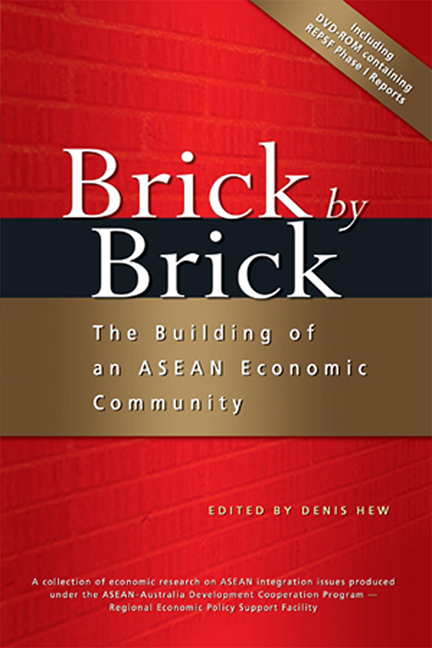Book contents
- Frontmatter
- Contents
- Foreword by Ong Keng Yong
- Foreword by Bruce Davis
- Acknowledgements by Academic Editor
- Acknowledgements by Technical Director REPSF
- The Contributors
- The Regional Economic Policy Support Facility
- 1 Introduction: Brick by Brick — The Building of an ASEAN Economic Community
- 2 What is a Single Market? An Application to the Case of ASEAN
- 3 The Challenge of Economic Integration for Transitional Economies of Southeast Asia
- 4 A Review of Regional Tariffs and Trade in the ASEAN Priority Goods Sectors
- 5 Non-tariff Barriers to Trade in the ASEAN Priority Goods Sectors
- 6 An Assessment of ASEAN's Priority Sectors for Fast-track Integration
- 7 ASEAN Tax Regimes: Impediment or Pathway to Greater Integration
- 8 An Overview of the Foreign Direct Investment Jurisprudence
- 9 ASEAN's FTA Negotiations with Dialogue Partners:Identifying Strengths and Weaknesses in Business Opportunities
- 10 Conclusion: Towards an ASEAN Economic Community by 2015
- Index
- Contents of Accompanying CD-ROM: AADCP-REPSF Phase I Research Program
4 - A Review of Regional Tariffs and Trade in the ASEAN Priority Goods Sectors
Published online by Cambridge University Press: 21 October 2015
- Frontmatter
- Contents
- Foreword by Ong Keng Yong
- Foreword by Bruce Davis
- Acknowledgements by Academic Editor
- Acknowledgements by Technical Director REPSF
- The Contributors
- The Regional Economic Policy Support Facility
- 1 Introduction: Brick by Brick — The Building of an ASEAN Economic Community
- 2 What is a Single Market? An Application to the Case of ASEAN
- 3 The Challenge of Economic Integration for Transitional Economies of Southeast Asia
- 4 A Review of Regional Tariffs and Trade in the ASEAN Priority Goods Sectors
- 5 Non-tariff Barriers to Trade in the ASEAN Priority Goods Sectors
- 6 An Assessment of ASEAN's Priority Sectors for Fast-track Integration
- 7 ASEAN Tax Regimes: Impediment or Pathway to Greater Integration
- 8 An Overview of the Foreign Direct Investment Jurisprudence
- 9 ASEAN's FTA Negotiations with Dialogue Partners:Identifying Strengths and Weaknesses in Business Opportunities
- 10 Conclusion: Towards an ASEAN Economic Community by 2015
- Index
- Contents of Accompanying CD-ROM: AADCP-REPSF Phase I Research Program
Summary
Introduction
In 2003 the ASEAN Concord II (also known as the Bali Concord II) established the ASEAN Economic Community with a view to integrate the economies of the ASEAN countries. This is outlined in the document, ASEAN Vision 2020. To this end, there is to be a free flow of goods, services, investment and skilled labour, and freer flow of capital in order to promote economic growth and development and reduce socio-economic disparities within the region. Further details on the background to the Agreement can be found in Lloyd and Smith (2004).
The Framework Agreement for the Integration of Priority Sectors was signed at the Tenth ASEAN Summit which was held in Vientiane, Laos on 29–30 November 2004. This Agreement outlined the steps to be taken to accelerate the integration of eleven major sectors in the ASEAN economies: agro-based products, air travel, automotive products, e-ASEAN, electronics, fisheries, healthcare, rubber-based products, textiles and apparel, tourism, and wood-based products.
A number of previous studies have examined the impediments to the integration of the ASEAN economies. This chapter contains an overview of trade performance and tariff rates in the priority sectors of the ASEAN economies. It also seeks to measure the degree of integration in these economies using measures of comparative advantage and intra-industry trade in the priority sectors.
To give a background, Table 4.1 compares the structure of the various ASEAN economies. In Cambodia, Laos, and Myanmar, the dominant sector is agriculture. Except for Singapore whose dominant sector is services, manufacturing is the dominant sector in the other countries.
Methodology
Data Sources
Trade flows. The source of data is Comtrade (www.unstats.un.org) for the period 2002–2004 and ASEAN Secretariat (www.aseansec.org) for 2005. Trade flows are analysed for nine of the eleven priority sectors: agro-based products, automotive products, electronics, fisheries, healthcare, information and communication technology (ICT), rubber-based products, textiles and apparel, and wood-based products. Some commodities are included in more than one sector.
Reporting by some countries is incomplete. For example, Singapore does not report all its trade flows with Indonesia. This can be overcome to some extent by examining the trade flows that are reported by the partner country. However, in some cases, goods passing through Singapore are simply re-exported. Data from Laos, Myanmar, Cambodia, and Vietnam are also problematic.
- Type
- Chapter
- Information
- Brick by BrickThe Building of an ASEAN Economic Community, pp. 59 - 85Publisher: ISEAS–Yusof Ishak InstitutePrint publication year: 2007

